What is it about this obscure writing duo called the Little sisters that made so many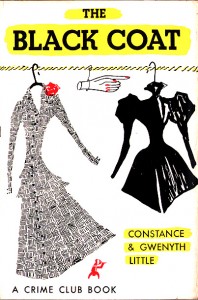 customers in the mystery book store where I worked willing to pay fairly large sums of cash for so-so reading copies of their titles? After providing a particularly thrilled recipient with a copy of Constance and Gwenyth Little’s BLACK WHATEVER, (all but the first Little book have “Black” in the title), I was compelled find out why — as soon as possible. Thus began MY search for all of the titles, in first edition for collecting, and in any other form for reading.
customers in the mystery book store where I worked willing to pay fairly large sums of cash for so-so reading copies of their titles? After providing a particularly thrilled recipient with a copy of Constance and Gwenyth Little’s BLACK WHATEVER, (all but the first Little book have “Black” in the title), I was compelled find out why — as soon as possible. Thus began MY search for all of the titles, in first edition for collecting, and in any other form for reading.
Thankfully, a couple of heroes came to rescue the Little sisters from mystery oblivion. Rue Morgue Press must have had similar experiences with customers, because they decided to reprint all 21 titles. Originally published between 1938 and 1953 by the Doubleday Crime Club, Constance and Gwenyth Little’s work was described on one flap, “There is all the humor and the amusing romance-in-reverse that one expects from a novel by the Littles, with a fair amount of the gore, mutilation, creaking doors and shadowy figures that are demanded in a detective story.” They must have been exceedingly popular in their time, for very few copies of their books exist today; not even ex-library copies can be found while many other mystery authors’ works are still available in that form. The best information available on the Little sisters is from the Rue Morgue Press, who relied on the late Ellen Nehr, author of THE DOUBLEDAY CRIME CLUB COMPENDIUM, and Constance and Gwenyth’s other sister, Iris Little Heitner (who herself wrote two mystery novels under the nom de plume Robert James.)
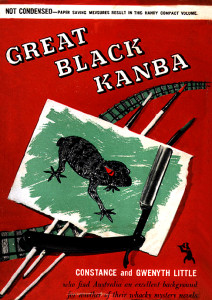 Tom and Enid Schantz of Rue Morgue Press interviewed the surviving younger sister. “We were a close family,” said Iris. Four of the five Little children were born in Sydney, Australia, where their father worked as an actuary. The family moved to western Australia, and then to London, Mexico City, and New York, finally settling down in, of all places, East Orange, New Jersey. From their unique childhood experiences, Constance and Gwenyth acquired a love of traveling. The sisters went around the world three times and likewise endowed their characters with a great deal of movement. In GREAT BLACK KANBA, the main character, after being thumped on the head by luggage, suffers from amnesia while traveling across Australia via train. In THE GREY MIST MURDERS, the murder scene is an ocean liner voyage. However, despite frequent travel themes, many of the Littles’ stories take place in crowded houses, hospitals, and boarding rooms. THE BLACK GLOVES is set in their hometown of East Orange.
Tom and Enid Schantz of Rue Morgue Press interviewed the surviving younger sister. “We were a close family,” said Iris. Four of the five Little children were born in Sydney, Australia, where their father worked as an actuary. The family moved to western Australia, and then to London, Mexico City, and New York, finally settling down in, of all places, East Orange, New Jersey. From their unique childhood experiences, Constance and Gwenyth acquired a love of traveling. The sisters went around the world three times and likewise endowed their characters with a great deal of movement. In GREAT BLACK KANBA, the main character, after being thumped on the head by luggage, suffers from amnesia while traveling across Australia via train. In THE GREY MIST MURDERS, the murder scene is an ocean liner voyage. However, despite frequent travel themes, many of the Littles’ stories take place in crowded houses, hospitals, and boarding rooms. THE BLACK GLOVES is set in their hometown of East Orange.
Constance married a clothing company executive, Gwenyth an insurance executive, and they both became the matronly women they often poked fun at in their books. Where they got the urge to write mysteries and why they decided to collaborate is still unknown. The Schantzes write, “Their parents were pleased, although Gwenyth told Ellen Nehr in an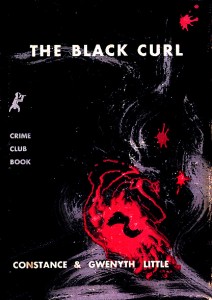 interview shortly before she died that, “our mother said she would have liked them better if we didn’t have such horrible murders in them.” Constance liked tennis, golf, theater, and bridge — a game that is featured in almost all of the titles. Ellen Nehr wrote, “Constance thought up the plots and outlined them fully, chapter by chapter, and even included clues and snips of conversation.” Gwenyth wrote the final draft. Although they lived close by for many years, Constance moved to Boston and their writing was done via telephone. “Constance called Gwenyth to complain ‘You’ve had the murderer sitting in the living room while the crime was being committed in the upstairs hall.’ She stated to Gwenyth, “I don’t care what you do, only don’t mess with my clues!” It has also been noted that they did much of the actual writing from their respective beds. Nice work if you can get it!
interview shortly before she died that, “our mother said she would have liked them better if we didn’t have such horrible murders in them.” Constance liked tennis, golf, theater, and bridge — a game that is featured in almost all of the titles. Ellen Nehr wrote, “Constance thought up the plots and outlined them fully, chapter by chapter, and even included clues and snips of conversation.” Gwenyth wrote the final draft. Although they lived close by for many years, Constance moved to Boston and their writing was done via telephone. “Constance called Gwenyth to complain ‘You’ve had the murderer sitting in the living room while the crime was being committed in the upstairs hall.’ She stated to Gwenyth, “I don’t care what you do, only don’t mess with my clues!” It has also been noted that they did much of the actual writing from their respective beds. Nice work if you can get it!
The Littles did not write series characters like many of their contemporaries. Each book had new names and faces, but all carried similar characteristics. Every Little heroine was a wisecracking, spunky woman; she was a bit spoiled, caustic in speech, not afraid to use a little bad language, and could quite often be found with cigarette and drink in hand, on the tail of a murderer. If that’s not what you would usually associate with the “good old years” of mystery fiction, well that’s just the point. The Littles were unique. They reflected society as it was during the late 1930s through the early 50s: people smoked, drank, and had as good a time as possible.
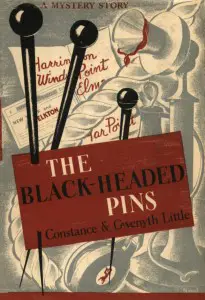 Of course in the wonderland world of Little, the merriment and wackiness was heightened to the point of absurdity. And that’s what makes them excellent stand-outs. The plots usually begin with the above-described spunky girl arriving at a large ramshackle house (or hospital) under a misunderstanding of some kind. Often the heroine is placed in a position of service, as a housemaid, companion, or even a friend caught up in a situation that requires her to stay and “help out” when a body is discovered. Leigh, in THE BLACK-HEADED PINS, is forced to become a companion to penny pincher Mrs. Ballister in the cold wilds of New Jersey (when there were still wilds to be found in the Garden State.) Mrs. Ballister has invited her nephews and nieces up for the annual Christmas party. A horrible dragging noise in the attic foretells that an imminent death will befall a member of the family! Leigh is stuck waiting hand and foot on the self-absorbed relatives. Callie, in THE BLACK PAW, is in an even more tenuous position. Having agreed to help her rich friend find the evidence her husband has obtained to begin a divorce, she agrees to infiltrate the husband’s house, disguised as the
Of course in the wonderland world of Little, the merriment and wackiness was heightened to the point of absurdity. And that’s what makes them excellent stand-outs. The plots usually begin with the above-described spunky girl arriving at a large ramshackle house (or hospital) under a misunderstanding of some kind. Often the heroine is placed in a position of service, as a housemaid, companion, or even a friend caught up in a situation that requires her to stay and “help out” when a body is discovered. Leigh, in THE BLACK-HEADED PINS, is forced to become a companion to penny pincher Mrs. Ballister in the cold wilds of New Jersey (when there were still wilds to be found in the Garden State.) Mrs. Ballister has invited her nephews and nieces up for the annual Christmas party. A horrible dragging noise in the attic foretells that an imminent death will befall a member of the family! Leigh is stuck waiting hand and foot on the self-absorbed relatives. Callie, in THE BLACK PAW, is in an even more tenuous position. Having agreed to help her rich friend find the evidence her husband has obtained to begin a divorce, she agrees to infiltrate the husband’s house, disguised as the 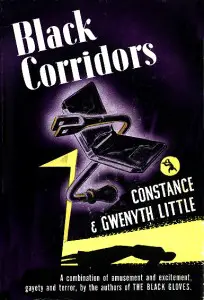 new housemaid. The only problem is that Callie is a spoiled young lady who’s never picked up a duster! Marina, in THE BLACK RUSTLE, is stuck in a house full of strangers when she only intended visiting a friend for the weekend. Miriel, in THE BLACK HONEYMOON, marries into her misery; her husband hasn’t a cent to his name so they are to inhabit the great family manse with unhappy in-laws. The Littles’ heroine prototype is single except for in THE BLACK HONEYMOON, and is not particularly looking for a man, but finds one anyway, even if she agrees to marry him out of spite and then is stuck with the deal, as happens in BLACK CORRIDORS. The heroine and the young eligible male never seem to hit it off and trade fabulous barbs with each other throughout the books. In THE BLACK RUSTLE, Marina not only suffers the indignity of Bruce, the hero, calling her everything from Maggie to Mamie, but is also misused as his assistant–left to handle huge planks of wood while he works on various projects for his large dilapidated home, he forgetting she’s even there. The passage begins by Bruce demanding:
new housemaid. The only problem is that Callie is a spoiled young lady who’s never picked up a duster! Marina, in THE BLACK RUSTLE, is stuck in a house full of strangers when she only intended visiting a friend for the weekend. Miriel, in THE BLACK HONEYMOON, marries into her misery; her husband hasn’t a cent to his name so they are to inhabit the great family manse with unhappy in-laws. The Littles’ heroine prototype is single except for in THE BLACK HONEYMOON, and is not particularly looking for a man, but finds one anyway, even if she agrees to marry him out of spite and then is stuck with the deal, as happens in BLACK CORRIDORS. The heroine and the young eligible male never seem to hit it off and trade fabulous barbs with each other throughout the books. In THE BLACK RUSTLE, Marina not only suffers the indignity of Bruce, the hero, calling her everything from Maggie to Mamie, but is also misused as his assistant–left to handle huge planks of wood while he works on various projects for his large dilapidated home, he forgetting she’s even there. The passage begins by Bruce demanding:
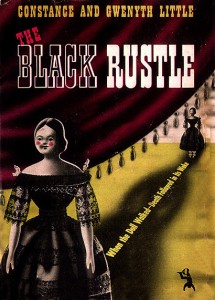 ‘”Here–stand on this and hold the end the way I have it. Bruce started at once to hammer all around my feet and I felt that at last I understood the feelings of a knife thrower’s assistant. After about two hours of it, a loud gong sounded from the direction of the dining room. Bruce said ‘wait a minute–wait a minute,’ and continued to work for about five minutes longer, when he reluctantly laid aside his hammer, and I was apparently dismissed.
‘”Here–stand on this and hold the end the way I have it. Bruce started at once to hammer all around my feet and I felt that at last I understood the feelings of a knife thrower’s assistant. After about two hours of it, a loud gong sounded from the direction of the dining room. Bruce said ‘wait a minute–wait a minute,’ and continued to work for about five minutes longer, when he reluctantly laid aside his hammer, and I was apparently dismissed.
A great example of the wit and dialog each title contains can be found in THE BLACK PAW. Callie, mistaken for a housemaid, is put to work immediately upon arrival at another large, multi-floored home. She is caught rummaging around the library by the owner:
“He looked me over coolly and spoke again. ‘Handsome-looking garment you’re wearing, where did you get it, fourteenth street? ‘I opened my mouth but no sound came out. So he added, ‘Or was it Fifth Avenue perhaps?’ Something that passed as an idea stirred in my brain and I blinked. ‘Where am I?’ Allan put the cigarette in his mouth and continued to regard me through the smoke. I tried to look dazed and stammered out, ‘I’m very sorry sir. I must have been sleepwalking. Been a bad habit since a nipper, sir.”
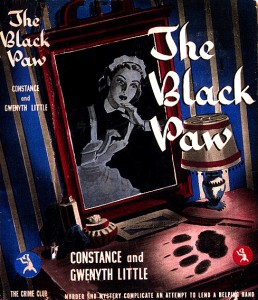
Later they had this exchange:
‘What’s your name?’
‘Callie Drake,’ I sighed
“Callie? That’s odd. What’s it short for?’
I felt anger stirring in me again. My mother had picked my name–I had always thought it rather pretty–and it wasn’t short for anything. I tried to keep my temper and said sulkily,
“Calisthenics.”
He half closed his eyes and regarded me from under the lowered lids.
‘I don’t care much care for nicknames. So if you don’t mind, I’ll call you by your full name.”
Verbal sparring permeates each book and lends a delicious romantic tinge that is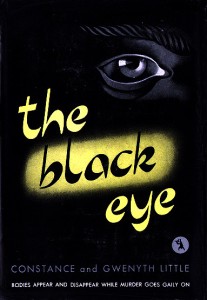 reminiscent of old black and white movies, where the couple didn’t even need to kiss, just like Fred and Ginger in their madcap dancing comedy movies. Part of the charm of the books lies in the lively banter between characters and the break-neck pace of the story. You hardly grasp how the first victim was done in when you have to grapple with outlandish clues like two black-headed pins, or black feathers, or black gloves, or a black eye, or a black thumb, or a black stocking, or black paw — I think you catch my drift. Their editor demanded everything be black, but the sisters were alway s joking about throwing in chartreuse colored clues to throw the publisher off.
reminiscent of old black and white movies, where the couple didn’t even need to kiss, just like Fred and Ginger in their madcap dancing comedy movies. Part of the charm of the books lies in the lively banter between characters and the break-neck pace of the story. You hardly grasp how the first victim was done in when you have to grapple with outlandish clues like two black-headed pins, or black feathers, or black gloves, or a black eye, or a black thumb, or a black stocking, or black paw — I think you catch my drift. Their editor demanded everything be black, but the sisters were alway s joking about throwing in chartreuse colored clues to throw the publisher off.
But it’s how the clues are used that’s the ingenious part. The black eye is a fake eyeball that one of the suspects keeps misplacing. The black rustle is a noise heard from a small china lady figurine’s shirt before disaster befalls a victim. The black thumb slips off a victim’s hand, a black coat is lent to a stranger, which in turn sends the heroine to the wrong boarding house and mistaken identity. Things keep appearing and disappearing, including people. A chair rocks by itself, a wallet is there one moment and gone the next, a patient appears to have died, and yet can’t be found, and even the body of a cook hidden by a person who thinks the cook is the murderer vanishes from a locked closet.
The books are riddled with what appears on the surface to be nonsensical happenings. But there is definite method to the Littles’ madness, and each book provides enough clues for the reader to guess the murderer in the tradition of the old “fair play rule” that reigned many years ago. All the weird occurrences are cleared up by the end of the story, and in a very logical manner.
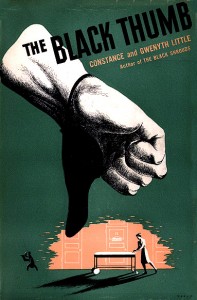 There are suspects aplenty in Littleland, and none have their heads screwed on too tight. An ex-doctor prowls the halls in his pajamas carrying a knife, a patient sings “John Brown’s Body” in the middle of the night, Aunt Violet is considered eccentric refusing to leave her room. But by and large, it is the groups of characters altogether that create the madcap comedy atmosphere of the books. Whole families sometimes appear in a title with extended wacky relations turning up dead; and quite often, the heroine’s somewhat irritating mother arrives to mangle whatever romantic interlude her daughter may be engaged in, as Elise does THE BLACK STOCKING. Fathers fair a bit better in the stories; they are completely inept but viewed with tolerance and affection by the heroine, even when he is the cause of lost fortune. In THE BLACK THUMB, the setting again a large house, although sterile and full of corridors for a murderer to roam. And a murderer does, using an ax to get his point across. In BLACK CORRIDORS, Jessie’s aunt suffers from splendid health, only she doesn’t want to believe it, so she forces her niece to stay with her in the darkened hospital while nurses and patients are being murdered hither and thither. Other titles with a hospital setting are THE BLACK SMITH and THE BLACK
There are suspects aplenty in Littleland, and none have their heads screwed on too tight. An ex-doctor prowls the halls in his pajamas carrying a knife, a patient sings “John Brown’s Body” in the middle of the night, Aunt Violet is considered eccentric refusing to leave her room. But by and large, it is the groups of characters altogether that create the madcap comedy atmosphere of the books. Whole families sometimes appear in a title with extended wacky relations turning up dead; and quite often, the heroine’s somewhat irritating mother arrives to mangle whatever romantic interlude her daughter may be engaged in, as Elise does THE BLACK STOCKING. Fathers fair a bit better in the stories; they are completely inept but viewed with tolerance and affection by the heroine, even when he is the cause of lost fortune. In THE BLACK THUMB, the setting again a large house, although sterile and full of corridors for a murderer to roam. And a murderer does, using an ax to get his point across. In BLACK CORRIDORS, Jessie’s aunt suffers from splendid health, only she doesn’t want to believe it, so she forces her niece to stay with her in the darkened hospital while nurses and patients are being murdered hither and thither. Other titles with a hospital setting are THE BLACK SMITH and THE BLACK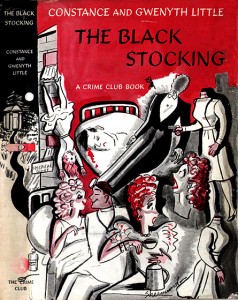 STOCKING. The hospitals are very small and private, not large enough to contain tons of suspects. In one title, the mystery is set on a quarantined floor. I guess this is the Little’s answer to the classic ‘stranded in a house during a snowstorm, thunder storm, bridge washout, etc., etc .Anything that confines a set group of suspects as the only possible murderers.
STOCKING. The hospitals are very small and private, not large enough to contain tons of suspects. In one title, the mystery is set on a quarantined floor. I guess this is the Little’s answer to the classic ‘stranded in a house during a snowstorm, thunder storm, bridge washout, etc., etc .Anything that confines a set group of suspects as the only possible murderers.
What all of the titles have in common, up until the last few, is the comic timing and screwball mentality of a classic movie comedy. One can picture Irene Dunne, Jean Arthur, or even Katherine Hepburn wise cracking their way through a typical outlandish Little plot, with the same hilarious results that films like Bringing up Baby, The Awful Truth, and most pointedly, The More the Merrier. In the latter, Jean Arthur takes boarders into her crowded apartment during the World War II housing shortage, in very similar fashion to the Littles’ THE BLACK EYE In this one, Eugenia and the male protagonist are sharing a cramped apartment against her will and exchange verbal barbs, just as Arthur and Joel MacCrea do in the film. And as in the film, the sparing couple ends up as just that — a couple.
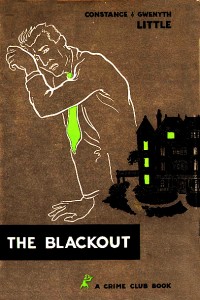 Most of the books take the first person narrative, but somewhere along the line that changed. I found the last few titles to have a very different tone and feeling; a much darker and less madcap atmosphere permeates the books. In THE BLACKOUT, there is the requisite house, slightly off-key characters, and a heroine and hero, but a somber note is introduced with an amnesia-ridden character, not in fun this time, but as a possible murderer. And the wildly odd sisters who play Russian roulette in THE BLACK IRIS are more disturbing than funny. (Rue Morgue explains the publisher had a piece of artwork that depicted two women with guns trained on each other and asled the Littles to write a mystery to match. Still, the tone of the books is not a screwball comedy) Why this turn in tenor is a question no one can answer, and may not have been noticed at the time. It is a subtle change, but because I was reading them in order, one after the other, the change is obvious. The Little sisters stopped writing, allegedly because they wanted to travel, but I can’t help but wonder if the change in atmosphere and style of writing might have led to fewer sales.
Most of the books take the first person narrative, but somewhere along the line that changed. I found the last few titles to have a very different tone and feeling; a much darker and less madcap atmosphere permeates the books. In THE BLACKOUT, there is the requisite house, slightly off-key characters, and a heroine and hero, but a somber note is introduced with an amnesia-ridden character, not in fun this time, but as a possible murderer. And the wildly odd sisters who play Russian roulette in THE BLACK IRIS are more disturbing than funny. (Rue Morgue explains the publisher had a piece of artwork that depicted two women with guns trained on each other and asled the Littles to write a mystery to match. Still, the tone of the books is not a screwball comedy) Why this turn in tenor is a question no one can answer, and may not have been noticed at the time. It is a subtle change, but because I was reading them in order, one after the other, the change is obvious. The Little sisters stopped writing, allegedly because they wanted to travel, but I can’t help but wonder if the change in atmosphere and style of writing might have led to fewer sales.
Tom and Enid Shantz speculate that times had changed and so had reading audiences. Other Crime Club authors saw declines in their sales and got out when the Littles did. There is no doubt that with the Mickey Spillane’s of the crime fiction world ruling best sellers lists, lighter fiction and so called ‘cosies’ were out of fashion. So for whatever reason, the Littles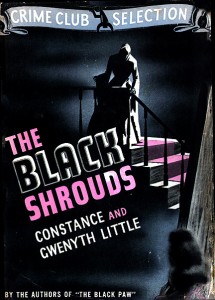 ended their mischievous run with THE BLACK IRIS in 1953. What is stunning about the Littles’ writing history, is for quite a while, they delivered two titles per year. So although their sum output is 21 titles, they only wrote for about 16 years.
ended their mischievous run with THE BLACK IRIS in 1953. What is stunning about the Littles’ writing history, is for quite a while, they delivered two titles per year. So although their sum output is 21 titles, they only wrote for about 16 years.
So what about their legacy? Are there any authors writing this kind of humorous mystery today? I was stunned when I encountered the now award-laden first effort by writer Donna Andrews; it might have been the ghosts of Constance and Gwenyth coming through in MURDER, WITH PEACOCKS. The heroine is roped into doing “service” as the maid of honor for multiple weddings; she stays at a populated house with a strong mother, she humors an inept father, and engages in a strange pairing with the hero. MURDER, WITH PUFFINS continues the de’ja’ vu feeling I get when reading; it seems as though the Little sisters are smiling at Ms. Andrews work. Murder With Puffins’s setting is an island during a hurricane in a close quartered house–with the entire family stranded. Eerily familiar in concept? Less you think I am hinting Ms. Andrews borrowed from the Littles — not so. Ms. Andrews had no knowledge of the Little sisters when I queried her, so the genius with which the sisters were endowed alighted upon Ms. Andrews quite independently of their influence. Since these first two, Ms. Andrews as gone on to be nominated again and again for this wonderful wildly funny series. Another author who reminds me of the Littles is Kris Neri, author of REVENGE OF THE GYPSY QUEEN and DEM BONES’ REVENGE. The oddity of characters and the madcap pace all contribute to a similarity in style between authors. And in a crazier, more hard-boiled way, Tim Dorsey’s frantic paced Florida series peopled with weird characters and insane situations, is almost a bastard child of the Littles. Instead of women protagonists, there are men, of course. Murderous men.
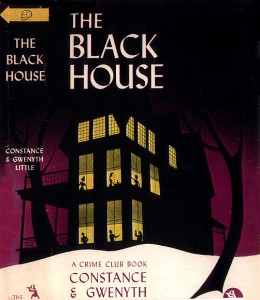 As for collecting first editions, good luck! I have seen two listings for their first novel THE GREY MIST MURDERS, in five years, and it was a hefty $600. (At the time I first wrote the article, I’d not collected very many of their titles. I was finally able to score 90 per cent in first edition, many in dust jacket, and even managed to nab a GREY MIST MURDERS!)
As for collecting first editions, good luck! I have seen two listings for their first novel THE GREY MIST MURDERS, in five years, and it was a hefty $600. (At the time I first wrote the article, I’d not collected very many of their titles. I was finally able to score 90 per cent in first edition, many in dust jacket, and even managed to nab a GREY MIST MURDERS!)
And although all of the titles are now available to read, thanks again to Rue Morgue, that wasn’t the case when I was researching this article — and there were a few titles I had not yet had the pleasure of reading. That’s not the case today–I’ve read them all–except the first–maybe I’m just not into grey! You dear readers are luckier! Chances are you are just starting out and have the entire collection of wacky wonderful laughable Littles to experience. Lucky little ‘ole you!’
For reprint copies of the Little sisters titles go to Rue Morgue Press at:
http://www.ruemorguepress.com/
Besides the Littles they have scads of Golden Age mysteries in reprint.
Plus, for some more details about Constance and Gwenyth Little they have a wonderful article here:

Great article and you’ve got me interested! I just requested the only 2 cataloged titles through our multi-library system, The Black Shrouds and The Black Thumb.
Good! The Black Thumb is particularly good. Let me know what you think–I wish someone would option one and make a period screwball comedy. Why no one did in the 40s, is beyond me. Thanks for reading and responding!
Oh, man! Am I ever loving The Black Thumb! I’m just scooting through it and laughing. Thank you for the tip, Diane. And you’re right, a screwball comedy would seem like a good thing, perhaps the Littles weren’t interested?
I’ve never heard that they were even engaged about it–seems as though they would have taken the dough, if only to travel more. The Littles are like potato chips, you won’t be able to read just one!